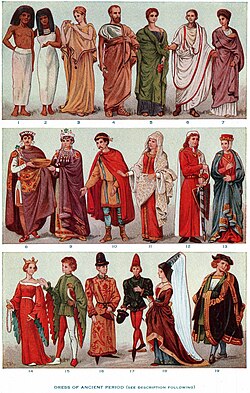
The palla was an elegant cloak or mantle that was wrapped around the body. It was worn outside the house by (affluent) Roman women. It was a luxurious version of the Roman men's pallium . [1] [2] [3] [4] The palla was a traditional ancient Roman mantle worn by women, fastened by brooches. The shape was rectangular instead of semi-circular, as with the traditional toga. [5] The garment dates to the 3rd century BC, [6] but the type of dress must be much older. [1] In Latin literature, the term palla is used ambiguously. [7] It can denote not only a cloak, but also a foot-length sleeveless dress with straps (or a brooch) worn directly on the skin. The second is a common dress form in the entire Mediterranean world. In a Greek cultural context, this is called peplos . In a Roman cultural context, if worn by a Roman matron, it also takes the name stola .
